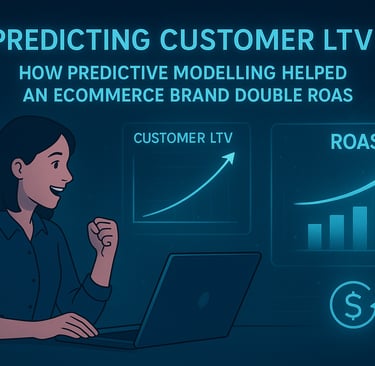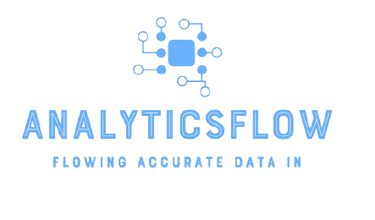Predicting Customer LTV – How Predictive Modelling Helped an eCommerce Brand Double ROAS
Mujaheed Abdul-Wahab
9/25/20252 min read


In a world where acquisition costs keep rising and consumer loyalty is harder to earn, the smartest brands are shifting focus from short-term conversions to long-term value.
For one eCommerce brand we worked with, understanding Customer Lifetime Value (LTV) became the key to smarter ad spend, more efficient targeting, and, ultimately, doubling their Return on Ad Spend (ROAS).
Here’s how predictive modelling turned raw data into actionable insights — and helped this brand build a marketing engine that scales profitably.
Customer Lifetime Value measures the total revenue a business can expect from a single customer throughout their relationship with the brand.
Traditional LTV looks backward — calculating based on past purchases. But with predictive modeling, we can forecast future value, even for customers with limited purchase history.
What Is Customer Lifetime Value (LTV)?
This eCommerce brand was heavily invested in paid social and search campaigns, but faced three key challenges:
Equal budget allocation — All campaigns were optimized for short-term revenue, ignoring future value.
Rising CAC — Cost per acquisition was increasing, making traditional ROAS metrics misleading.
Lack of data integration — CRM, analytics, and ad data lived in silos, preventing a holistic view of customer behavior.
They needed a way to identify which customers were truly worth investing in, not just today, but in the long run.
The Challenge
At AnalyticsFlow, we built a predictive LTV model powered by BigQuery, GA4 data, and machine learning algorithms.
The Predictive Modelling Approach
We integrated multiple data sources:
GA4 event data (user sessions, conversions, purchase frequency)
CRM and email engagement data
Google Ads and Meta Ads performance metrics
BigQuery became the single source of truth, allowing us to analyze user journeys from first click to repeat purchase.
Step 1: Unified Data in BigQuery
Step 2: Feature Engineering
We created behavioral and transactional features such as:
Average order value (AOV)
Time between purchases
Campaign source and channel engagement
Product category affinity
On-site engagement (scroll depth, session duration, events triggered)
Step 3: Building the Predictive Model
Using Python’s scikit-learn and BigQuery ML, we trained a regression model that forecasted future LTV per user based on these features.
Step 4: Segmenting High-Value Customers
Once the model scored each customer’s predicted LTV, we segmented them into three groups:
High-value (top 20%) – strong repeat potential
Mid-value – opportunity for re-engagement
Low-value – focus on acquisition optimization
These insights were then synced back to Google Ads and Meta to refine lookalike and remarketing audiences.
The Results
Integrate your data stack – Connect GA4, CRM, and ad data into BigQuery.
Model customer behavior early – Don’t wait for years of data to start predicting.
Activate insights in ad platforms – Use predictive LTV segments for smarter bidding and remarketing.
Measure impact beyond short-term revenue – ROAS is just the start; profitability is the goal.
Home | About | Solutions | Case Studies | Contact
AnalyticsFLOW
Contact Email: support@analyticsflow.io
Mobile: +1-718 725 7745
© AnalyticsFlow 2025
